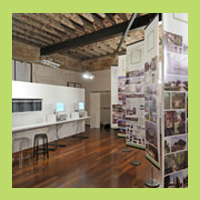
Outstanding places 2008
second edition
The eagerness and willingness to respond to the call were therefore far from fulfilled with the first 2007 edition.
On the contrary, we have realised that the development of the Outstanding Places competition is getting happily complicated.
First of all, the breadth of the response: 188 nominations were received from the same area, the province of Treviso (with 7 places that had already been reported in 2007 and 16 first edition respondents who participated again) compared to 152 in 2007, more than three hundred messages in two years, which could not be more varied by choice, language, motivations and reasons. In other words, we now know that a significant portion of civil society is committed to working on issues that might seem light years removed from real daily worries, but are actually perceived as close, urgent, current, even pivotal in our society.
And again — as with Outstanding Places 2007 — the generosity and variety of responses, the wealth of the region highlighted by the map of nominations and by participants’ stories; the confirmation that value criteria emerging from the materials are not based on any monumental characters of the sites or purely aesthetic evaluations.
This unusual cultural experience in close contact with a diversity of people provides us with sources and documents that help us understand how a site is not a sphere “around” the person and community, or an optional context, but rather how it is an essential component of the vital sphere, a necessary substance of the human condition. Such that, more commonly than one would think, the traumatic transformation of a place is viewed and experienced like the actual loss of a part of oneself.
What exactly constitutes a site had perhaps been deduced and mentioned in the previous years: nature, memory, social unrest, human condition, invention, care (or neglect), all of these blend together in a recognisable shape and life that unfold in an identifiable territory. But what is the value of a site based on? This extensive collective study offers a few suggestions. First of all, it is perceived as something universal. Every site, no matter which, expresses its gravitational energy towards someone. There is an individual, a small group, a community that recognises it as their “own”, that indeed perceives it as a part of themselves.
And we seem to understand that this energy stems especially from memory, from knowledge accumulated over time by previous generations and handed over to today’s witnesses. Memory and knowledge may even appear as inspiration, emotion, affection, but they are and essentially remain memory and knowledge, hence closeness, intimacy and familiarity with a site’s shape and life, with all that there is and has been over time — the extremely long span of geology, the long course of time of the layers of historical transformations, and the short time of current tensions.
The fact that this blessed value resides in the close relationship of knowledge and familiarity between site and individual appears to be proven through the spatial allocation and topographic precision used to report the sites. A house, a school, a church, a specific route, a clearly marked open space, a natural location. The relationship, hence the value, is built by points, by microcosms, all displayed in the exhibition of the nominations of the 2008 Outstanding Places competition, open to the public at the Fondazione Benetton Studi Ricerche culture spaces of Palazzo Bomben from 25 October, 2008 to 8 February, 2009.
